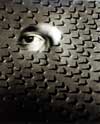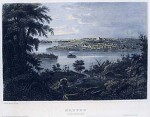|
Art Activities and Lesson Plans
 - Applique Quilt Activity
Put patriotic motifs onto the quilt top, position or rotate them, and color them to create an applique quilt like those that Helen Gilchrist, age 17, did in 1842. Based on the Gilchrist bedcover in the Museum's collection. This activity requires a flash plugin on your computer, which may be downloaded for free on the Macromedia site.
 - Loaves - Painting Composition Activity
Arrange loaves of bread, a knife, and a jug onto a canvas to create different compositions from the same elements that Macena Barton used in her painting, which is in the Museum's WPA collection. This activity requires a flash plugin on your computer, which may be downloaded for free on the Macromedia site.
 - Log Cabin Pattern Quilt Design Activity
Create a log cabin pattern design of your own or copy one from the examples by rotating blocks on a grid of 16 blocks. Quilters can use this to try out patterns. Anyone can use it for fun or a visual challenge. This activity requires a flash plugin on your computer, which may be downloaded for free on the Macromedia site.
 - Applique Bedcover Design Lesson
- Using 17-year-old Helen Gilchrist's 1840s applique bedcover as inspiration, and the Classical Revival Period motifs, design your own applique quilt top.
 - Art in the Abstract: Scale Project
- During two to three sessions, middle through high school students can reproduce an abstract unit focusing on the artistic element of scale.
 - Art in the Abstract: Text-messaging Project
- individual and group project in which students write a short description of a painting from this presentation in text-messaging style, switch messages with others, and try to guess which painting was being described from the visual vocabulary learned in the presentation.
 - Artistic Analysis of a Photograph Lesson pdf
- Photography is not only an historical medium; it is also an artistic medium. Using Frank Sadorus's turn-of-the-20th-century photographs and Nathan Lerner's 1930-40s photographs, learn to look for artistic elements in the composition, light effects, poses, and developing techniques. Many of the style elements that were popular in the visual arts of a given time appeared not only in painting and sculpture, but also in photography.
 - Beautiful and Sublime Landscapes in Illinois
- This lesson from Lewis and Clark in Illinois describes the 18th and 19th century aesthetics that influenced Lewis and Clark when they went West. Look at three of the Museum's 19th century landscapes, then create you own using this aesthetic.
 - Compare Artists Lesson pdf
- Students will compare the work of artists working in the same time and place to detect influences. Sometimes artists working in the same place and time communicate about art, see one another's art, and influence one another. Learn to recognize similarities and detect influences.
 - Decoys - Foul or Fair?
- This discussion lesson introduces students to critical analysis of historical artifacts. Discuss, using photographic examples from the decoy collections of several museums, just how life-like decoys need to be, and which physical characteristics of waterfowl are considered by decoy makers when they create their carvings for hunters to use.
 - Design a Piece of Furniture
- Each style period of the 19th century contained its own motifs. After veiwing the Web exhibit and the labeled drawings of a piece from each period, students will look at other pieces of furniture (print sources, home, at stores), identify motifs, and select some to use to create their own unique piece of furniture.
 - Finding Historical Design Motifs Lesson Plan pdf
- Study historical and modern furniture styles through images and find historical motifs in modern furniture. Discuss why designs of the 19th century and before persist today, and whether they are worth saving.
 - Forms for Exhibit Creation Lessons
- In the Classroom Exhibit lesson for the Behind the Scenes module, students can print out and use forms to keep records of the objects or specimens they are planning to exhibit.
 - Genre Painting Lesson pdf
- Learn how artists portrayed everyday life in the nineteenth century by painting landscapes peopled with humans and animals doing many activities at once to illustrate the life of the farm or family they were painting.
 - Geometric-pieced Quilt Lesson
- Lower grades can create a pieced paper quilt using fabric squares and triangles. They will learn how quilters use shapes to create larger shapes and color patterns.
 - Hexagon Pieced quilt design lesson
- Albert Small used tiny hexagons to create marvelous quilts. Bertha Stenge used traditions hexagons to create oriental-style designs for her quilts. See their quilts on the Keeping Us in Stitches quilt module, then make your own.
 - Historical Object Research Form pdf
- Historians use forms to record information they find out about their historical objects. Students can use this when doing their research on objects of their own for their classroom exhibit.
 - Interviewing a Quilter Lesson pdf
- Part of a history unit including quilts might emphasize the human side of quilting. Invite a quilter to the classroom and ask her/him questions about quilting. List and organize your questions to cover the quilter's life, family, reasons for quilting, etc.
 - Local Motifs Quilting Design Lesson
Inspired by one of Bertha Stenge's applique quilts, this lesson plan helps students choose motifs from their life and locality to create a quilt top.
 - Log Cabin Quilt Block Lesson
- The Log Cabin section of the Museum's Keeping Us in Stitches Quilt module contains many versions of the Log Cabin Block and sets. Play the computer interactive version and/or print out the grid and color your blocks.
 - Making Connections Lesson
- This theme activity involves students using images of objects and art to practice interpreting themes.
 - Native American Dye Plants Lesson
- Learn how to create fabric dyes from natural substances in onion skins, walnuts, and flowers the way Native Americans and early settlers did. Dyed cloth can be used to make a prairie quilt (see lesson plan) or garment, or dye samples notebook.
 - Ojibwa Sewn Bead Designs Lesson Plan pdf
- Native Americans sewed glass beads onto leather and cloth to decorate clothing and objects. Learn how to sew seed beeds on felt, and go on to decorate your own clothes!
 - Patriotic Applique Design Lesson pdf
- In the mid-nineteenth century, quilters sometimes used patriotic images in their applique quilts. Given one made by 17-year-old Helen Gilchrist, students will choose their own patirotic motifs and create a paper quilt top. There is also an interactive appplique quilt top activity on our web site.
 - People at Work Lesson Plan pdf
- Work was one of the five themes that WPA artists were asked to use in their work. View artworks by the WPA artists on this theme, and create your own painting using the types of jobs we see today.
 - Polymer Clay Trade Bead Lesson pdf
- View the Museum's Frost Trade Bead Collection Online and the Morton Barker Paperweight Collection online to find out how millefiori beads were made from glass, and hos they were traded in America. Create your own beads from polymer clay.
 - Polymer Clay Trade Beads Lesson
- Using the Frost Trade Bead Collection Online and the Barker Paperweight Colleciton online, students will learn how millefiori beads are made from glass and will learn to do a similar technique in ploymer clay.
 - Portrait Painting Lesson pdf
- The Museum's Folk Art Web Exhibit contains early Illinois portraits by itinerant painters. Learn how they ran their art businesses in the 19th century.
 - Quilt Detective Lesson pdf
- You can discover the approzimate date of your quilt by checking the types of fabrics, the colors, and the pattern.
 - Sadorus: Outdoor Photography Lesson pdf
- Frank Sadorus specialized in outdoor photography in the first decade of the 20th century. He used light and shadow to create moods and special effects. Study his prints and get ideas for your own outdoor photography.
 - Story Quilt
- Students will view the video or web site of Fay Ringgold. Using the style of her quilts, i.e., a picture painted in the center, surrounded by a pieced border, and writing included as a narrative.
 - Symmetry in Butterflies Lesson pdf
- There are three principles of protective coloration in butterflies. Explore these principles and create a 3-D painted butterfly with a symmetrical protective coloration. (also see the interactive on this lesson)
 - Talking About Art Lesson pdf
- Look at some paintings from the Museum's collecitons and discuss the elements of art or principles of design that the artists used to create them.
 - Theorem Painting Lesson pdf
- In the nineteenthe century, theorem paintings were often done by young ladies practicing their painting skills.
 - Urban and Rural Life: WPA Art Lesson pdf
- Students will analyze a WPA art work on a rural or urban theme and explain how the artist used the elements of art (line, space, value) to emphasize the theme or mood of the art work.
 - Weaving Beads on a Loom Lesson Plan pdf
- This lesson from the Museum's Native American module focuses on bead weaving techniques. You can buy or construct a bead loom and, using a needle and thread and seed beads, weave a bracelet, ring, or even a necklace.
 - Webquest: Flower Symbolism pdf
- This lesson plan comes from the Barker Paperweight Colleciton online. The lampworked paperweights have floral designs that would have had special meaning when they were made in the nid-mineteenth century. Victorians used the gift of flowers to send messages to people -- messages of love, sympathy, and other emotions. The Internet has many sites dedicated to this idea. You can find the meaning in some of the Museum's decorative arts motifs, or in the floral motifs of your own objects or art.
 - Whole Cloth Quilt Lesson pdf
- Whole cloth quilts consist of one large piece of plain fabric for the quilt top. The quilter uses her sewing lines to create a pattern. Using paper and white pencil, students can create a classical or fantasty quilting design.
 - WPA Themes in Art Lesson pdf
- Work, stolen moments, American scene, modern sensibility, and social realism were themes that American artists used in their work for the WPA. Look at some examples and create your own painting on one of the themes.
 - Writing from a Point of View Lesson pdf
- Read a story written from the point of view of a piano's life with a family and then try your hand at writing from the point of view of an inanimate object.
|
|
|



